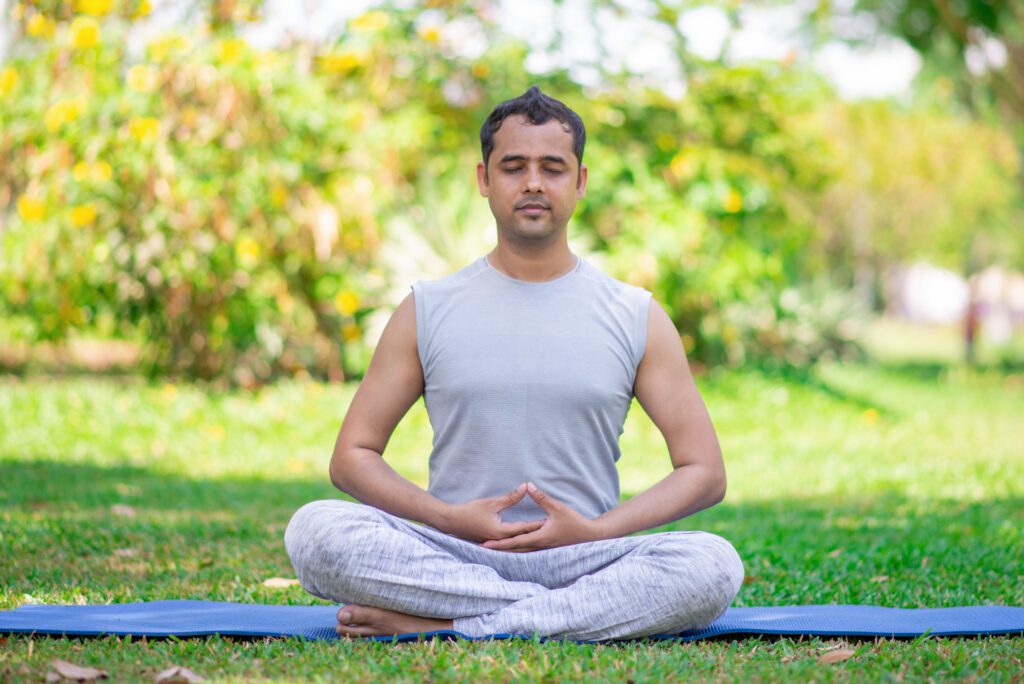Kapalbhati is a yogic breathing technique (pranayama) that involves rapid, forceful exhalations and passive inhalations. The term “Kapalbhati” is derived from two Sanskrit words: “Kapal,” meaning skull, and “Bhati,” meaning shining. The practice is believed to cleanse the lungs and energize the mind.
How To Practice Kapalbhati

-
Sit Comfortably:
Find a comfortable seated position. You can sit on the floor with your legs crossed or on a chair with your feet flat on the ground. Ensure that your spine is straight.
-
Relax Your Shoulders:
Relax your shoulders and place your hands on your knees, palms facing upward in a receptive gesture. You can also adopt a specific hand mudra if you prefer.
-
Take a Deep Breath:
Inhale deeply through your nose, expanding your lungs and diaphragm.
-
Forceful Exhalations:
Exhale forcefully and quickly through your nose by contracting your abdominal muscles. The emphasis is on the exhalation; the inhalation happens passively as the abdomen relaxes.
-
Repetition:
Continue the rapid and forceful exhalations followed by passive inhalations. Start with a moderate pace and gradually increase the speed as you become comfortable with the practice.
-
Focus on Abdominal Movement:
Pay attention to the movement of your abdomen. It should move inward with each forceful exhalation and relax outward with each passive inhalation.
-
Maintain a Steady Rhythm:
Try to maintain a steady rhythm throughout the practice. You can start with a few rounds and gradually increase the duration as your stamina improves.
-
Complete the Practice:
To conclude the practice, take a few deep breaths and allow your breathing to return to its natural rhythm. Sit quietly for a moment and observe the sensations in your body.
Benefits of Kapalbhati

-
Detoxification:
Kapalbhati is believed to cleanse the lungs and respiratory system, expelling stale air and toxins.
-
Improved Lung Function:
The forceful exhalations in Kapalbhati may enhance lung capacity and improve respiratory function.
-
Increased Oxygenation:
The practice is thought to increase the intake of oxygen, promoting better oxygenation of the blood and tissues.
-
Strengthening Abdominal Muscles:
Kapalbhati involves the contraction of abdominal muscles, which can contribute to the strengthening of the core.
-
Energizing and Invigorating:
Practitioners often report feeling energized and invigorated after a session of Kapalbhati.
-
Stress Reduction:
The rhythmic breathing and focus on exhalations may have a calming effect on the mind, helping to reduce stress and anxiety.
-
Improved Digestion:
Kapalbhati is believed to stimulate the digestive organs, potentially aiding in digestion.
-
Enhanced Mental Clarity:
Regular practice of Kapalbhati is thought to clear the mind, enhance mental clarity, and improve concentration.
-
Weight Management:
Some practitioners suggest that Kapalbhati may help in weight management by engaging the abdominal muscles and promoting metabolic activity.
Conclusion
Kapalbhati, a strong yogic breathing strategy, offers various medical advantages and promote overall well-being. Its musical and strong exhalations assist with further developing lung limit, reinforce abs, and upgrade respiratory capability.
Kapalbhati also invigorates the stomach related framework, detoxifies the body, and increments mental clearness and concentration. Regular practice of Kapalbhati under proper guidance can contribute to reduced stress, improved energy levels, better digestion, and a clearer mind. It is an effective practice for cultivating physical, mental, and emotional wellness, making it a valuable addition to a balanced lifestyle.
Recommended Blog : https://yogayurvedaa.com/anulom-vilom-steps-health-benefits/
